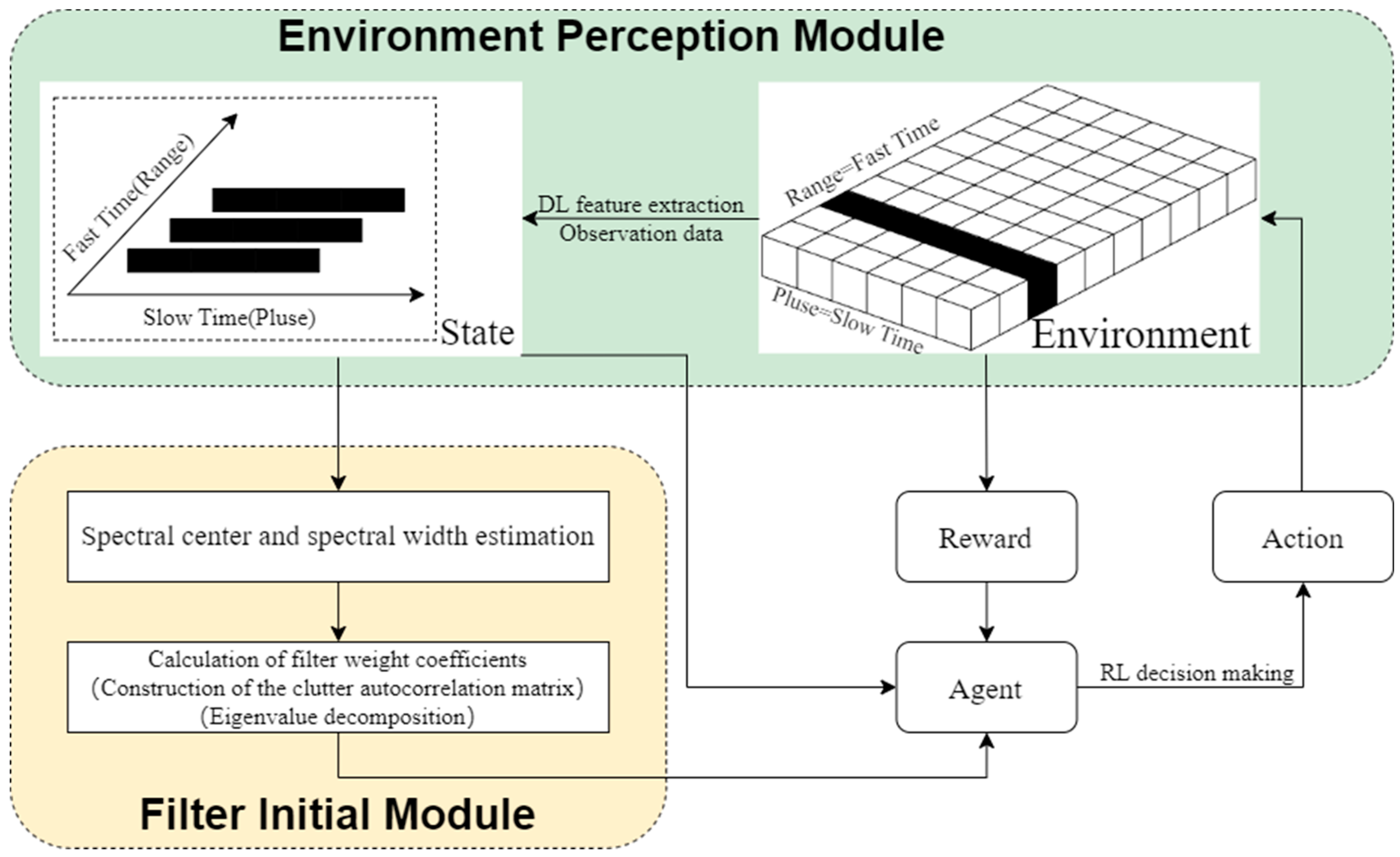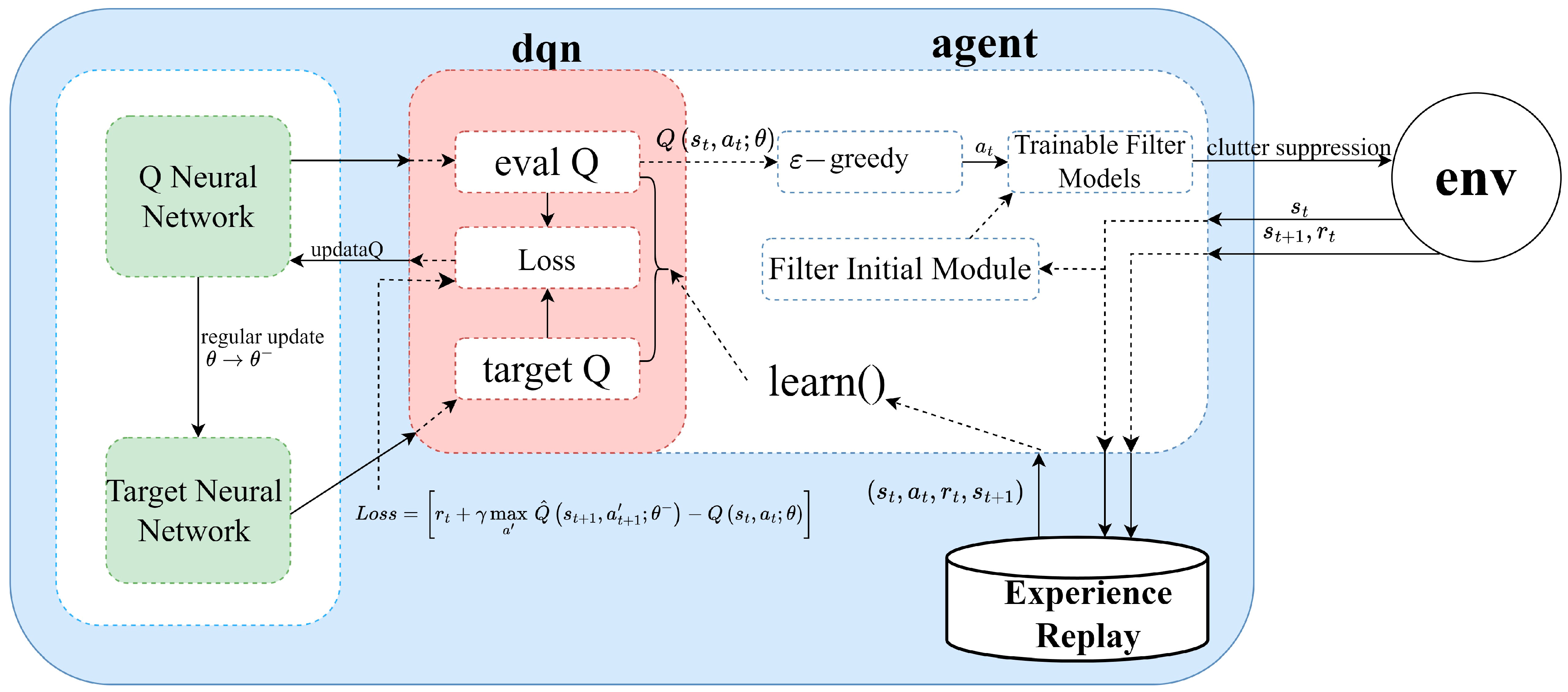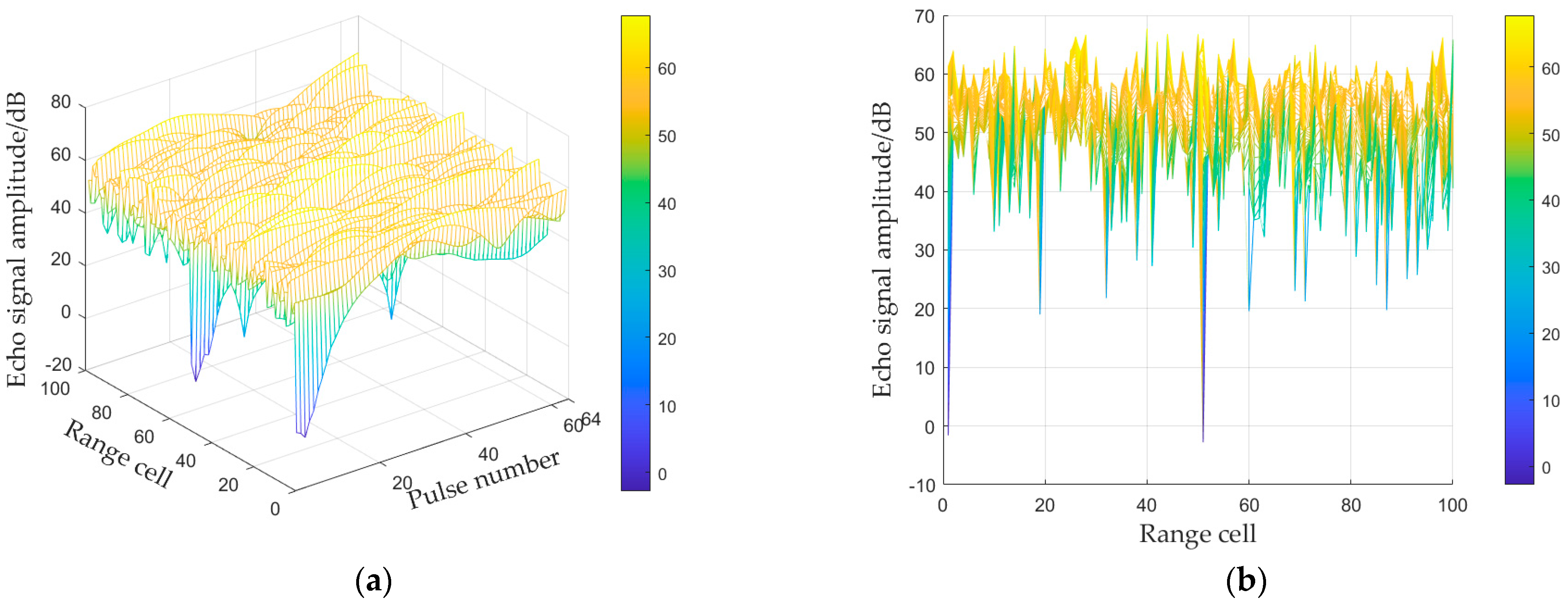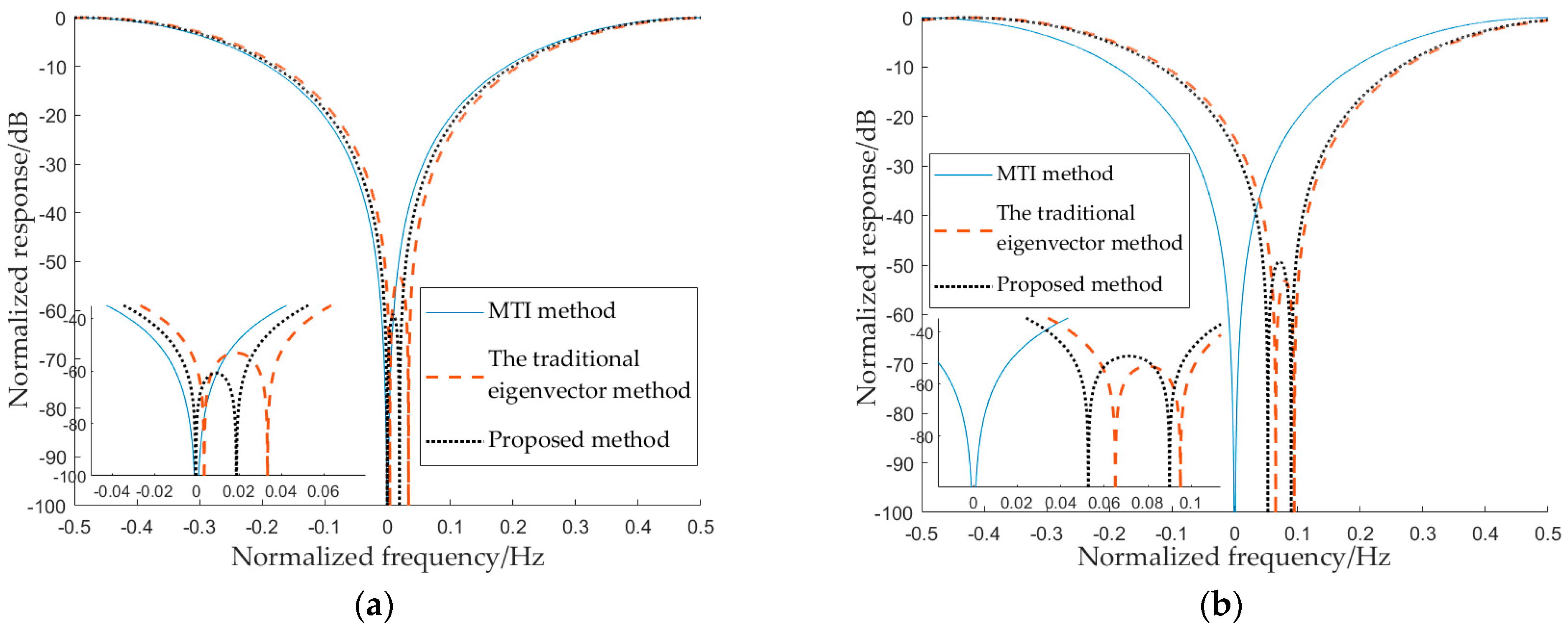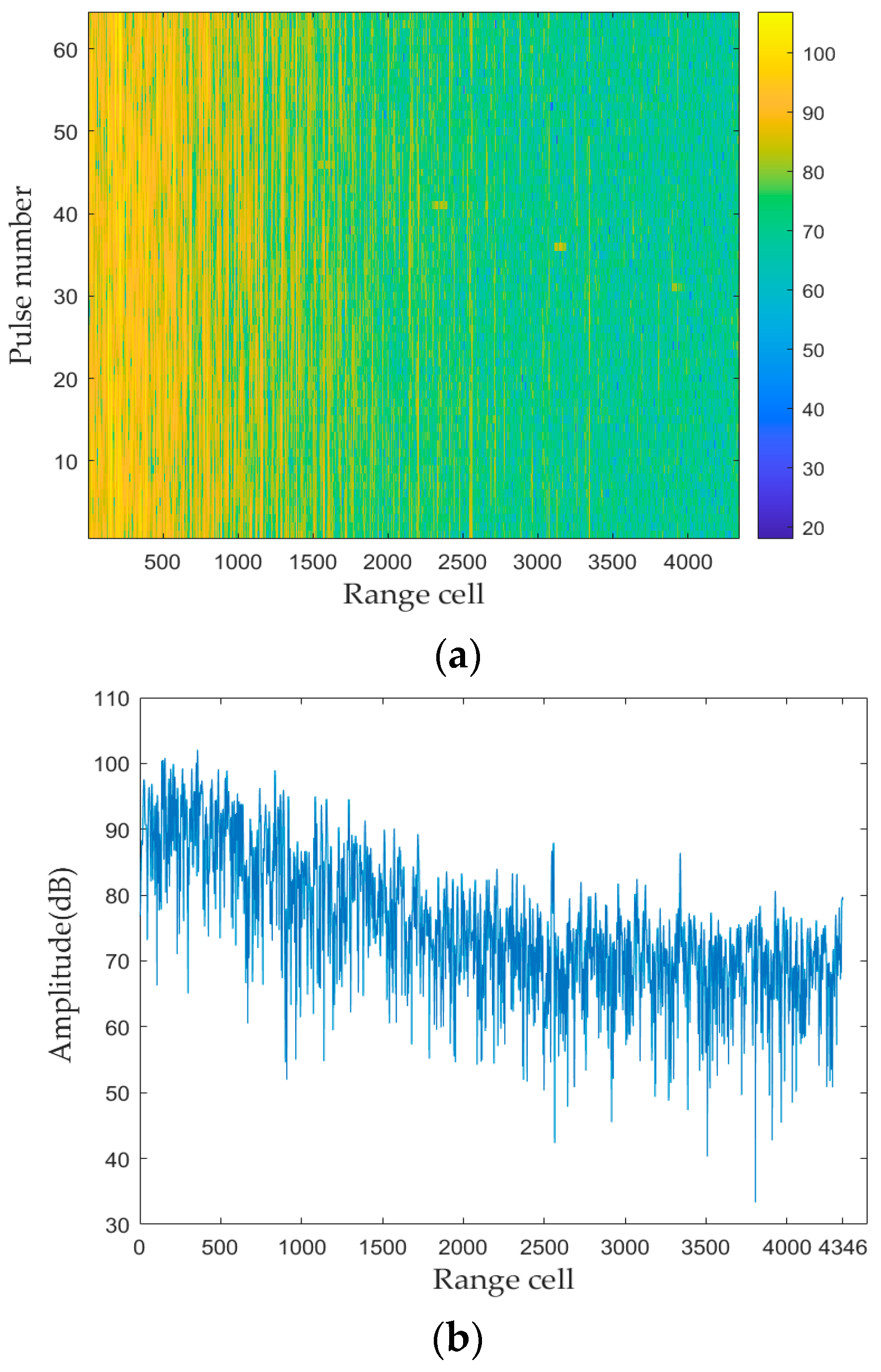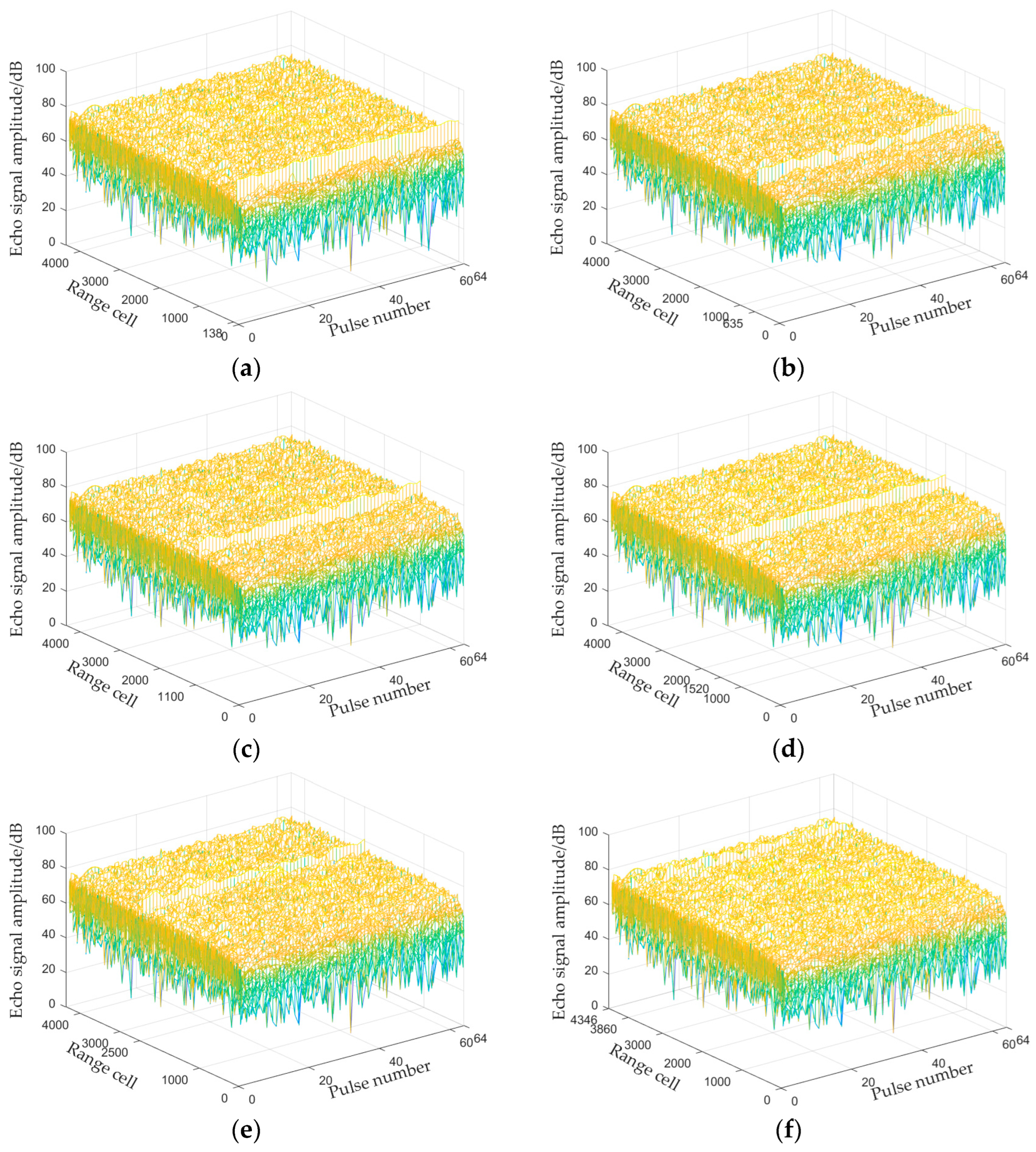In this section, the proposed method is validated and analyzed by conducting simulation data and real data experiments. The following experiments involved in the calculation of the formula on SCNR refer to Equation (11). In the simulation experiment, the K clutter distribution at different clutter center frequencies is simulated, and the simulation target is added to compare and analyze the enhancement ability of the SCNR before and after clutter suppression. In the measured data, the sea clutter is the real echo data, and there are more obvious strong sea clutter regions, clutter–noise mixing regions, and long-distance noise regions, and simulation targets are added in different clutter regions to test the performance of the filter designed by the proposed method in different clutter environments. The simulation parameters of the DQN are shown in
Table 1. The estimated value network and target value network have the same structure and both use fully connected neural networks with three layers: the input layer, hidden layer, and output layer. The number of neurons in the hidden layer is 64, and ReLU is used as the activation function.
5.3. Analysis of Suppression Effects under Measured Clutter Data
The performance of the sea clutter suppression method is analyzed using data from the sea-detecting X-band experimental radar [
27,
28], located at the sea target detection test site in the coastal area of Yantai, Shandong Province. The experimental data are selected as pure sea clutter data from the scanning radar echo data numbered “20210106155330_01_staring”, which takes 64 pulses and 4346 range cells. The parameters of the X-band experimental radar are shown in
Table 7.
The 2D echo signal and the first pulse echo signal of the radar data are shown in
Figure 8. For the 2D echo signal shown in
Figure 8, the sea clutter amplitude in this data decreases with the increase in distance, and it can be roughly divided into three clutter regions: Clutter region 1: the first 1000 range cells are the strong sea clutter region, and the average power of the sea clutter is 90.3762 dB. Clutter region 2: 1001~2000 range cells are the clutter–noise mixing region, and the average power is 80.7891 dB. Clutter region 3: 2001~4346 range cells are essentially the noise region, and the average power is 70.974 dB.
In this section, the experiments will test the clutter suppression effect of the four methods under different clutter intensity regions of the real data and the simulation target with an input SCNR of −10 dB, respectively. The 138th and 635th distance cells are selected to be added to the simulation target in the clutter region 1 where the average power of sea clutter is about 90 dB, the 1100th and 1520th distance cells are selected to be added to the simulation target in the clutter region 2 where the average clutter power is about 80 dB of clutter–noise mixing, and the 2500th and 3860th range cells are selected to be added to the simulation target in the noise region of clutter region 3 with an average power of about 70 dB. A total of six sets of experiments are conducted, and
Figure 9 shows the results of the proposed method after clutter suppression.
From
Figure 9, it can be seen that the adaptive clutter suppression method based on DRL can still effectively suppress the sea clutter under different clutter intensity environments, but there are some differences in the clutter suppression effect of different range cells. In the strong sea clutter region and the clutter–noise mixing region, the clutter suppression effect is significantly better than in the noise region. This is because the sea clutter energy in clutter region 1 and clutter region 2 is higher than the target energy when the input SCNR is −10 dB, and the sea clutter spectral characteristics are more obvious. After obtaining the estimated clutter spectral center and the spectral width, the agent explores and exploits near the clutter spectral center to optimize the parameter settings of the filters and to change the width of the filters. In the case of minimizing the loss of the target signal, a notch is formed in the center of the clutter, and the sea clutter in that range cell is completely filtered out. Meanwhile, due to the different distribution of sea clutter in each range cell, the exploration and utilization strategies of agents will be different. For example, at range cell 138, the proposed method is able to achieve a higher output SCNR gain with a lower input SCNR. Meanwhile, in the clutter–noise mixing region, where both clutter and noise exist, the spectral analysis of this range cell is more complex, which makes the agent require more frequent and complex adjustments for exploration and exploitation, thus affecting the optimal parameter configuration of the filter. This leads to the difficulty of achieving the same optimization effect for agents in the hybrid noise and clutter region in the same training rounds. In the noise region, the energy is more dispersed, the spectrum of the clutter signal is not concentrated, the energy is low, and the spectral characteristics are not as obvious as in the strong sea clutter region and the clutter–noise mixing region. Moreover, the average clutter power in the noise region is 70.9746 dB, the energy of the clutter signal is lower than that of the target signal, and the spectra of the clutter and the target signal overlap more, so it is difficult to find obvious spectral characteristics to locate the center of the clutter, which leads to the clutter suppression effect not being as effective as in the strong sea clutter region and the clutter–noise mixing region.
Table 8 shows the statistics of SCNR before and after the clutter suppression of each method in different clutter strength environments. It can be seen that the MTI method is effective in different clutter environments, and the output SCNR is stabilized at about 7 dB. The effect of environments with different clutter strengths on the performance of the MTI method is not significant, which is due to the fact that the notch depth of the MTI filter cannot completely suppress the clutter component of this range cell, and there is a certain Doppler shift in the sea clutter, so the suppression effect is limited. The suppression performance of the SVD method shows a decrease in the output SCNR or even an invalid suppression of the clutter as the clutter environment changes. This is because the clutter signal is easily recognized and removed when the power of the clutter signal is much larger than the power of the target signal, so the singular value decomposition (SVD) method effectively separates the clutter signal and suppresses it in clutter region 1. In clutter region 2, the average power of the clutter is about 80 dB, and the energy of the target signal is close to that of the clutter signal, so it is difficult for the SVD method to clearly distinguish between the target signal and the clutter signal during the decomposition, which leads to a decrease in the effect of separating the signal from the clutter. Clutter region 3 is a noise region without obvious sea spikes, and the target signal energy is higher than the clutter energy, the target is mistakenly canceled as sea clutter, and the SVD method is invalid. Compared with the MTI method, the traditional eigenvector method increases the SCNR by about 2 dB in each clutter region, while the proposed method further increases the SCNR by adding a deep Q-network to interact with the environment and continuously learning, which makes the position of the filter notch “more accurate”, “deeper”, and “wider” and further improves the output SCNR to about 15 dB in average. Overall, the proposed method exhibits excellent SCNR in different clutter environments.
From
Figure 4, it can be seen that when the target is located at the 23rd range cell and is in clutter region 1, the clutter center frequency is 0 Hz. At this time, the three-pulse MTI can suppress the clutter in clutter region 1. Since the target’s frequency is located at 440 Hz, which is farther away from the zero frequency, the target is not completely eliminated, but there is a loss of the target signal power, which is 37.5464 dB, and the target signal is reduced by 7.4536 dB. Due to the higher frequency of the clutter in clutter region 2, it can be seen that the clutter in this region is not completely suppressed in
Figure 4a, but the clutter is attenuated after the three-pulse canceller.
Figure 4b,c show the comparison of the clutter suppression of the traditional eigenvector method and the proposed method. Clutter 1 and 2 regions are suppressed because the two methods produce a depression in the center of the clutter frequency, so as to carry out the suppression of the clutter. The maximum power of the target after the processing of the two methods is 40.0157 dB and 41.0291 dB, respectively, the given target power is 45 dB, and the comparison of the data shows that the loss of target power is minimized after the clutter processing of the proposed method in this paper.
From
Figure 5, it can be seen that for the clutter with a certain center frequency, the MTI method cannot effectively suppress the high-frequency clutter, and the target in clutter region 2 is still masked after the MTI three-pulse canceller. While the traditional eigenvector method and the proposed method are still effective in suppressing the clutter to highlight the target, the target signal power is reduced compared to the experimental results of the clutter at 0 center frequency. This is due to the clutter center frequency of clutter region 2 being at 150 Hz. When the feature vector method predicts the clutter center frequency and produces a depression at 150 Hz, while the target is located at 440 Hz, the target frequency is closer to the clutter center frequency, which inevitably attenuates the signal of the neighboring frequency, resulting in a reduction in the target signal power. The maximum power of the target is 35.5389 dB and 36.5576 dB, and the SCNRs are 21.2227 dB and 22.9845 dB, respectively. The filter designed by the proposed method in this paper still outperforms the traditional eigenvector method in clutter region 2.
Figure 6a shows the filter response curves of the three methods when the target is located in the 23rd range cell. The MTI three-pulse canceller generates a notch at the zero frequency, and the depth of the notch meets the need for clutter suppression, but the width of its zero-frequency notch is insufficient to completely filter out the clutter. The traditional eigenvector method produces a notch at the center of the corresponding clutter frequency to suppress the clutter under the prediction of clutter information, which can completely filter out the clutter but inevitably loses part of the signal energy. The method proposed in this paper explores and exploits the same predicted clutter spectrum near the center, optimizes the parameter settings of the filter, and changes the filter width. It can be seen that the filter notch designed by the method proposed in this paper is much narrower and is able to completely suppress the clutter while having a higher amplitude-frequency response to signals at non-clutter frequencies, thus reducing the loss of the target signal. In
Figure 6b, the conventional eigenvector method produces a notch near 150 Hz, on which the proposed method further optimizes the filter notch width and position to suppress clutter while reducing the target signal loss, while the three-pulse cancellation still produces a notch at the zero frequency, which is unable to suppress the non-zero-frequency clutter.
In conclusion, by analyzing the above four sets of experiments, it can be found that the proposed method in this paper outperforms the MTI three-pulse canceller and the traditional eigenvector method in terms of the combined performance of clutter suppression processing and the degree of target power loss.
From
Figure 7a, it can be seen that when the clutter is located at the zero frequency, the output SCNR of the three methods is significantly improved. As the target speed decreases, the output SCNR gradually decreases, due to the fact that the low-speed target is close to the zero frequency, which overlaps with the clutter frequency resulting in poorer clutter suppression. When the clutter is located at 150 Hz, it can be seen from
Figure 7b that the notch generated by the MTI three-pulse canceller at zero frequency cannot completely suppress the clutter at 150 Hz, but the clutter is attenuated. In contrast, the traditional eigenvector method and the proposed method in this paper can move the notch of the filter to 150 Hz and suppress the clutter completely. As the speed decreases and the Doppler frequency of the target is close to 150 Hz, the clutter suppression effect of the two methods deteriorates, but the adaptive clutter intelligent suppression method based on DRL can still suppress the clutter while minimizing the loss of the target signal, and its output signal heterodyne noise is still higher than that of the traditional eigenvector method. When there are two clutter center frequencies of clutter at the same time, the suppression effects of the three methods are shown in
Figure 7c, the MTI three-pulse method does not work for the non-zero-frequency clutter, and it still plays the role of clutter attenuation. Meanwhile, the traditional eigenvector method and the method proposed in this paper can generate double notches in the frequency domain according to the spectral centers of different clutter and generate notches at −150 Hz and 150 Hz at the same time, both of which can completely suppress the clutter, but the filter designed by the method proposed in this paper has a higher output SCNR and a lower loss of target power compared to the filter designed by the traditional eigenvector method.
In conclusion, the adaptive clutter intelligent suppression method based on DRL shows higher output SCNR and lower target power loss under different target speeds and different clutter frequencies, which proves its superior performance and strong adaptive ability in complex environments. In addition, through the dynamic adjustment and optimization of the filter parameters, the method can effectively respond to environmental changes, avoid the performance degradation caused by the complexity and uncertainty of the environment, and improve the stability of the system.
